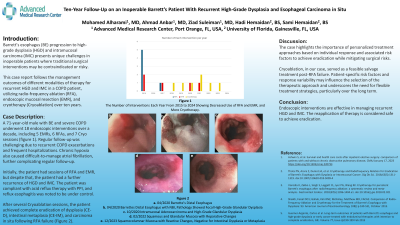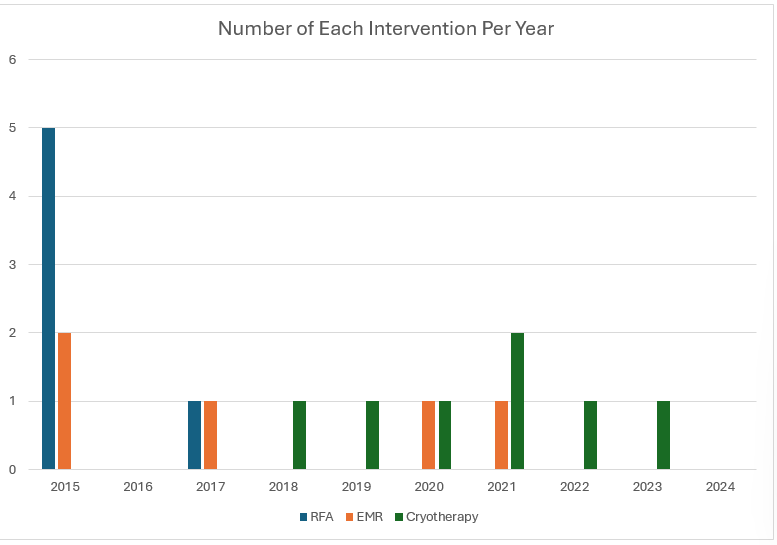Monday Poster Session
Category: Interventional Endoscopy
P2819 - Ten-Year Follow-Up on an Inoperable Barrett’s Patient With Recurrent High-Grade Dysplasia and Esophageal Carcinoma in Situ
Monday, October 28, 2024
10:30 AM - 4:00 PM ET
Location: Exhibit Hall E

Has Audio
- AA
Ahmad Anbar, MD
Advanced Medical Center
Port Orange, FL
Presenting Author(s)
Mohamed Hekmat Alharami, MD1, Ahmad Anbar, MD2, Ziad Suleiman, MD3, Sami Hemaidan, BA4, Hadi Hemaidan, BA5
1Advanced Medical Research Center, Port Orange, FL; 2Ochsner LSU Health, Lafayette, LA; 3Southwest Healthcare MEC, Murrieta, CA; 4University of Florida, Port Orange, FL; 5Florida International University, Port Orange, FL
Introduction: Barrett’s esophagus (BE) progression to high-grade dysplasia (HGD) and intramucosal carcinoma (IMC) presents unique challenges in inoperable patients where traditional surgical interventions may be contraindicated or risky. This case report follows the management outcomes of different modalities of therapy for recurrent HGD and IMC in a COPD patient with BE, utilizing radio-frequency ablation (RFA), endoscopic mucosal resection (EMR), and Cryotherapy (Cryoablation) over ten years.
Case Description/Methods: A 71-year-old male with BE and severe COPD underwent 18 endoscopic interventions over a decade, including 5 EMRs, 6 RFAs, and 7 Cryo sessions ( figure 1). Regular follow-up was challenging due to recurrent COPD exacerbations and frequent
hospitalizations. Chronic hypoxia also caused difficult-to-manage atrial fibrillation, further complicating regular follow-up. Initially, the patient had sessions of RFA and EMR but despite that, the patient had further recurrences of HGD and IMC.
The patient was compliant with acid reflux therapy with PPI and reflux esophagitis was noted to be under control.
After several Cryoablation sessions, the patient achieved complete eradication of dysplasia (CE-D), intestinal metaplasia (CE-IM), and carcinoma in situ following RFA failure.
Discussion: The case highlights the importance of personalized treatment approaches based on individual response and associated risk factors to achieve eradication while mitigating surgical risks. Endoscopic interventions are effective in managing recurrent HGD and IMC. The reapplication of therapy is considered safe to achieve eradication. Cryoablation in our case served as a feasible salvage treatment post-RFA failure. Patient-specific risk factors and response variability may influence the selection of the therapeutic approach and underscores the need for flexible treatment strategies, particularly over the long term.

Disclosures:
Mohamed Hekmat Alharami, MD1, Ahmad Anbar, MD2, Ziad Suleiman, MD3, Sami Hemaidan, BA4, Hadi Hemaidan, BA5. P2819 - Ten-Year Follow-Up on an Inoperable Barrett’s Patient With Recurrent High-Grade Dysplasia and Esophageal Carcinoma in Situ, ACG 2024 Annual Scientific Meeting Abstracts. Philadelphia, PA: American College of Gastroenterology.
1Advanced Medical Research Center, Port Orange, FL; 2Ochsner LSU Health, Lafayette, LA; 3Southwest Healthcare MEC, Murrieta, CA; 4University of Florida, Port Orange, FL; 5Florida International University, Port Orange, FL
Introduction: Barrett’s esophagus (BE) progression to high-grade dysplasia (HGD) and intramucosal carcinoma (IMC) presents unique challenges in inoperable patients where traditional surgical interventions may be contraindicated or risky. This case report follows the management outcomes of different modalities of therapy for recurrent HGD and IMC in a COPD patient with BE, utilizing radio-frequency ablation (RFA), endoscopic mucosal resection (EMR), and Cryotherapy (Cryoablation) over ten years.
Case Description/Methods: A 71-year-old male with BE and severe COPD underwent 18 endoscopic interventions over a decade, including 5 EMRs, 6 RFAs, and 7 Cryo sessions ( figure 1). Regular follow-up was challenging due to recurrent COPD exacerbations and frequent
hospitalizations. Chronic hypoxia also caused difficult-to-manage atrial fibrillation, further complicating regular follow-up. Initially, the patient had sessions of RFA and EMR but despite that, the patient had further recurrences of HGD and IMC.
The patient was compliant with acid reflux therapy with PPI and reflux esophagitis was noted to be under control.
After several Cryoablation sessions, the patient achieved complete eradication of dysplasia (CE-D), intestinal metaplasia (CE-IM), and carcinoma in situ following RFA failure.
Discussion: The case highlights the importance of personalized treatment approaches based on individual response and associated risk factors to achieve eradication while mitigating surgical risks. Endoscopic interventions are effective in managing recurrent HGD and IMC. The reapplication of therapy is considered safe to achieve eradication. Cryoablation in our case served as a feasible salvage treatment post-RFA failure. Patient-specific risk factors and response variability may influence the selection of the therapeutic approach and underscores the need for flexible treatment strategies, particularly over the long term.

Figure: Figure (1): Bar Chart Showing the Number of Each Intervention Per Year
Disclosures:
Mohamed Hekmat Alharami indicated no relevant financial relationships.
Ahmad Anbar indicated no relevant financial relationships.
Ziad Suleiman indicated no relevant financial relationships.
Sami Hemaidan indicated no relevant financial relationships.
Hadi Hemaidan indicated no relevant financial relationships.
Mohamed Hekmat Alharami, MD1, Ahmad Anbar, MD2, Ziad Suleiman, MD3, Sami Hemaidan, BA4, Hadi Hemaidan, BA5. P2819 - Ten-Year Follow-Up on an Inoperable Barrett’s Patient With Recurrent High-Grade Dysplasia and Esophageal Carcinoma in Situ, ACG 2024 Annual Scientific Meeting Abstracts. Philadelphia, PA: American College of Gastroenterology.
